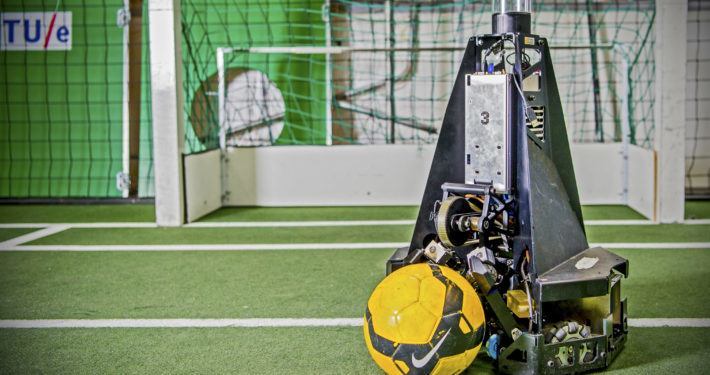
News
Software is critical for matches between soccer robots and human teams
- 9 May 2016
ICT Group and Fontys hope to contribute to this goal by founding a soccer robot team. Oscar Reynhout and Wim Hendriksen, consultant at ICT Group and lecturer at Fontys ICT college respectively, tell the story of how things came together and what challenges the team faces. The Netherlands have been active in the Robocup since 1998. The TechUnited soccer robot team from the Technical University Eindhoven (TU/e) has participated regularly and were world champions in 2012 and 2014. For many years now, the team has been alone at this high level. This is partly because the competition has been thinning out, largely due to a steep entry cost of about 25,000 euros per soccer robot, but also due to the high technical complexity of the robots.
Affordable soccer bots
In order to attract more competitors, the TU/e took up the challenge of developing an affordable soccer robot a few years ago: the Turtle 5K. This redesigned version of the 2012 cup winner is available for ‘just’ 5.000 euros. The main difference with its illustrious predecessor is that the Turtle 5K does not know how to play soccer. It comes with just a bare bones Linux-based Robot Operating System (ROS). The ROS contains the necessary drivers for the available hardware, like the omni-wheels the robot uses to move around. The buyer has to tweak both software and hardware to achieve a functional soccer robot. One of the buyers, photolithography systems manufacturer ASML, has achieved success in this regard, taking part in the 2015 Robocup in China.
Software development
Near the end of last year, ICT Group got involved with the project following a request from Frank Steeghs, project leader of Turtle 5K. As a side project, ICT’s Oscar Reynhout guided sixteen students of ICT college and Avans colleges through the development of soccer robot software. This software aims to improve the soccer robot’s performance. For ICT group, this project is a unique opportunity to gather experience both with robotics and artificial intelligence.
Oscar: “For my colleagues and I this is a fantastic hobby project. As a business we recognize the immense value of being able to experiment with new ideas and technologies, especially given the rise of robotics in sectors like care taking and industry. Additionally, we maintain intense relationships with both education institutes and SME’s thanks to this project. It is very interesting, both from a business and recruitment point of view.”
Their own soccer team
The students started developing the software in September 2015. They were divided into four teams: architecture, motion, model driven development and ROS. In just 6 months’ time, they got the robot to detect the ball, drive towards it, and kick it at the goal. Fontys’ Wim Hendriksen speaks with pride about his students, “They started from scratch, so this is really an astonishing feat”. This success got Wim and Oscar dreaming about a soccer robot team of their own. Wim elaborates, “We are now looking for SMEs with complementary abilities, in order to found a soccer robot team together. Such a partnership would allow us to purchase several robots at once, cutting down production costs. A lot of companies showed interest at the High-Tech Systems expo last March, so I fully expect the team to materialize.”
Model Driven Development
According to Oscar, the new team will initially focus on beating ‘mechanical engineering’ teams from the region. “TechUnited and ASML’s robots for example, are primarily made by folk working in electronics and mechanics. We want to beat them with excellent software.” One of the biggest challenges will be avoiding as many mistakes as possible during programming. Wim explains, “Robots can’t make logical mistakes like a dead lock (robots waiting for one another). Currently, one in a hundred lines of code contains a bug. However, thanks to programming methods like model driven development we can code at a more abstract level, reducing the chances that faults will slip in.” Oscar adds, “You can compare it to Microsoft Word’s spellchecker. Currently, if you make a mistake you’ll see a red line. It’d be a lot better if Word automatically corrected grammatically incorrect sentences, and in an ideal world the tool would even change sentences with faulty content. That last example is what model driven development allows us to do.”
According to Robocup’s organisers, software will allow soccer bots to beat human players by 2050. Oscar elaborates, “The difference between FC Barcelona and PSV is not in physical conditioning, but rather in technique and strategy. This is no different for robots: their technique needs to be on point to allow for skilful passing and dribbling. However, great team play will ultimately bring the soccer bots victory. Unfortunately, by the time that happens, I think I will be retired.” Reading about robot soccer is fun, but really you should see it.



